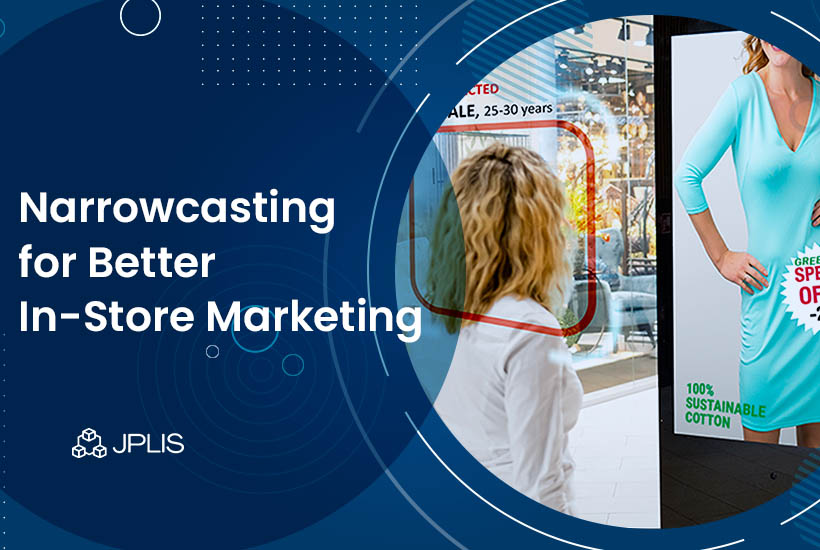Estimated Reading Time: 5 minutes
Narrowcasting is a way for businesses to use digital signage to target specific audiences with tailored messaging. This method of communication has been around for some time, but is seeing wider appeal as software integrations and newer display technology make it more beneficial. These advances make it easier to serve content at more locations while targeting customers at more points during their customer journey. Let’s take a look at the benefits of narrowcasting for businesses, and how marketers can use it effectively.
What is Narrowcasting?
Narrowcasting is the practice of presenting content (media, announcements, ads) that is specifically tailored to meet the needs of a certain audience. This can be incredibly valuable for businesses, as it allows them to target their customers more effectively for better engagement and higher conversions. You can target your audience for narrowcasting based on physical location, past actions and more.
For location-based narrowcasting this can take the form of ads served online like search engine ad campaigns or social media ads. It can also be used to present content to visitors at a brick and mortar store location through dedicated digital signage.
Benefits of Narrowcasting for Businesses
By providing customers with effective and targeted messaging, narrowcasting can help to increase customer engagement and improve the customer experience. In turn, this helps to increase digital visibility for businesses, reduce advertising costs, enhance product discovery and sales, allow for better strategy and more data gathering with insights, enhance brand loyalty, increase the reach of campaigns to targeted audiences, and generate higher ROI from marketing activities.
Narrowcasting offers businesses several advantages over general marketing campaigns. First, it can be far more targeted and specific, which means that your message will be more likely to hit home with your customer base. Second, because narrowcasting is focused on meeting customer needs specifically, it can lead to higher conversion rates and lower customer churn rates than general marketing efforts.
Because narrowcasting is designed around exclusivity (only those who need to know about your product or service will see it) this can create loyalty and word-of-mouth advertising among your customer base that you would never otherwise receive.
Let’s take a look at the different types of businesses that can benefit from using narrowcasting in their marketing strategy. Any company with products or services that consumers may want but don’t always see in their usual search results or during their normal shopping routine would benefit from using narrowcasting tactics. This includes companies in industries such as technology (where new products are constantly being released), health & fitness (where people are always looking for new advice), and hospitality.
Narrowcasting for the Technology Sector
Targeted campaigns for SaaS solutions can be displayed in stores alongside related hardware.This is a great way to teach customers how to get the most out of a new purchase. Some product offers are even paired with coupons received in-store to help customers continue their journey online.
Narrowcasting for Health and Fitness
Gyms, spas and wellness centers can use digital displays to showcase special workshops and products to existing clients. By learning about these offers early they can sign up early to classes with limited space and catch deals for new items. They can also be used to inform clients of upcoming changes to scheduling, equipment and more.
Narrowcasting for Hospitality
The hospitality sector uses narrowcasting to share important announcements with guests through digital displays. They also serve navigational content, to lead guests into discovering other services offered on the same property or off-site, such as tours, car services and other rentals.
The Components of Narrowcasting for Business
Successful narrowcasted campaigns involve several key components. Tend to customers at more points during their journey with the right combination of on-site marketing.
Narrowcasting Through Digital Displays
For presenting announcements and tailored offers to walk-in traffic the location needs crystal clear displays installed professionally at key points within the space. If the screens themselves are presentable while delivering crisp imaging and sound (audio is optional) then they are more likely to grab the attention of clients and guests.
Digital signage can be installed in high-traffic areas for maximum views. Wall mount digital signage in reception areas, waiting rooms and lobbies. Where wall mounting isn’t an option look into digital signage pylons.
Narrowcasting Via Guest Wi-Fi
Businesses can also take advantage of narrowcasting through customers’ own devices with marketing over Wi-Fi. This works better for marketing rather than for important announcements as it requires users to first log in and check their devices. However it has the added benefit of allowing the business to collect email addresses and social media handles for delivering tailored offers at a later date and even after the visitor has left the location.
Creating and Serving Content for Narrowcasting
Content creation is the next part of the process. The content should use clear, branded designs that quickly grabs the visitor’s attention. Remember, depending on the location you might have a small window to get your message across. The type of content that gets used is up to the brand but it’s important to note that short video content is rising in popularity.
Next is serving content. Some business owners serve content directly from their local devices and this works well. When there is someone in-house to create and manage the media involved. What is becoming more common however is the use of digital signage content management systems hosted online. These allow easier access to various types of content and the ability to manage digital displays independently. Specific content can be chosen for one display over another and even switched easily. Depending on event changes the operating times of different sections of the store.
With online management business owners can manage permissions. And receive work from graphic designers that is ready to go once it has been approved. Not only can content be served to different screens at one store location, but for multiple locations as well and with the same ease of management.
Special Targeting with Narrowcasting
With dynamic content, creating targeted content based on specific products. Topics and keywords can reduce the time needed to manage each campaign. Show products for women at a time when there is high traffic from women. (like a female-centric gym class) or highlight special tours for certain times of day or a specific day of the week.
Narrowcasting can also be generated and served dynamically based on data fed into the software from 3rd party channels. This data allows deeper targeting when sourced from systems that help to narrow down. Demographics by attributes not available in the store owner’s own data sources otherwise. For example, a retail store might display ads based on environmental factors such as weather, pollen forecast or traffic conditions. This allows business owners to serve up content directly related to the environmental conditions. That nearby audiences are experiencing right at that moment.
Finally, it’s important to track results regularly in order to gauge success and adjust accordingly if necessary! By following these tips – and some simple math. You’ll be well on your way to achieving maximum ROI from your narrowly focused marketing efforts!
Effectively Reaching Your Target Audience with Narrowcasting
While narrowcasting is an effective marketing strategy, there are some challenges associated with using this approach. Depending on the product or service offer. It can be difficult to measure the success of narrowcasting campaigns. Which can make gauging the return on investment difficult. Research into the target market is required in order not to miss any opportunities. By using careful planning and research along with the right hardware implementations. Narrowcasting can be effective in reaching the desired audience for better user engagement.
How Marketers Can Use Narrowcasting Effectively
By targeting on-site audiences that are already engaged with the company’s existing offers. Owners can generate upsells and continued service much faster.
Any business with an interest in reaching specific demographics within their existing reach can benefit from using this technique correctly. With proper data analysis and feedback collection. It’s easy to create campaigns that are tailored specifically to their needs at important points in their customer journey.
To Sum Up
Narrowcasting is a powerful marketing tool that can help businesses to reach on-site target audiences in more ways. Increase customer engagement and loyalty, reduce advertising costs, and generate a higher return on investment. By creating targeted content through digital signage displays, businesses can set up successful campaigns with narrowcaster content.





